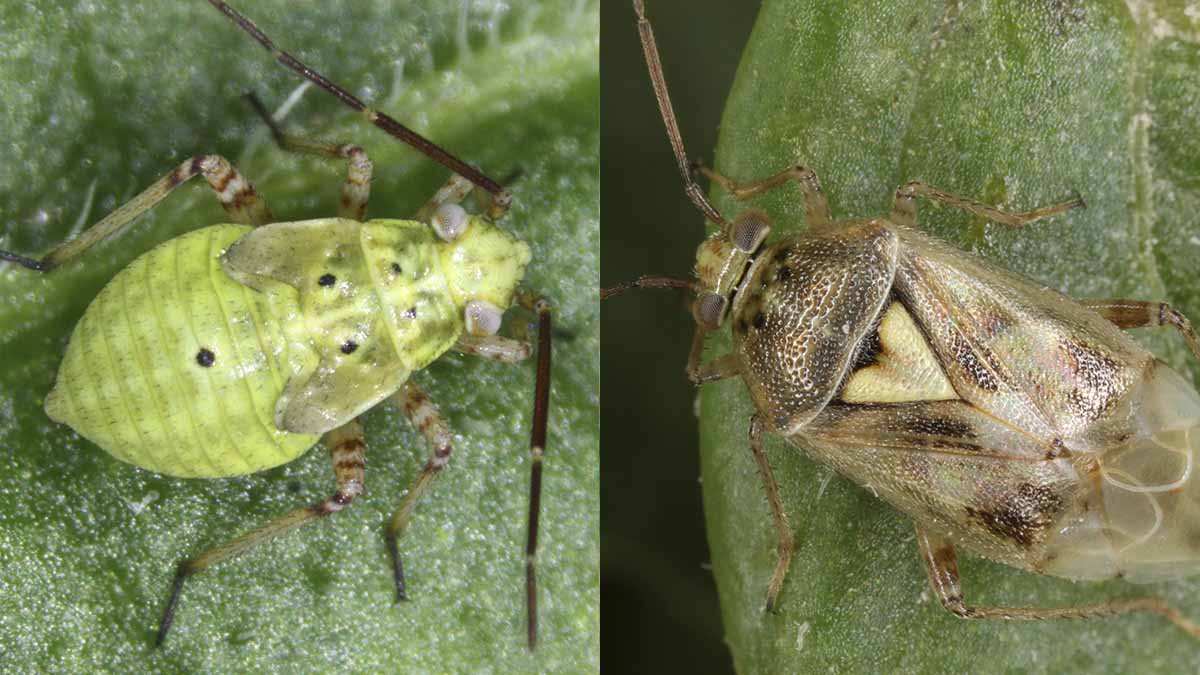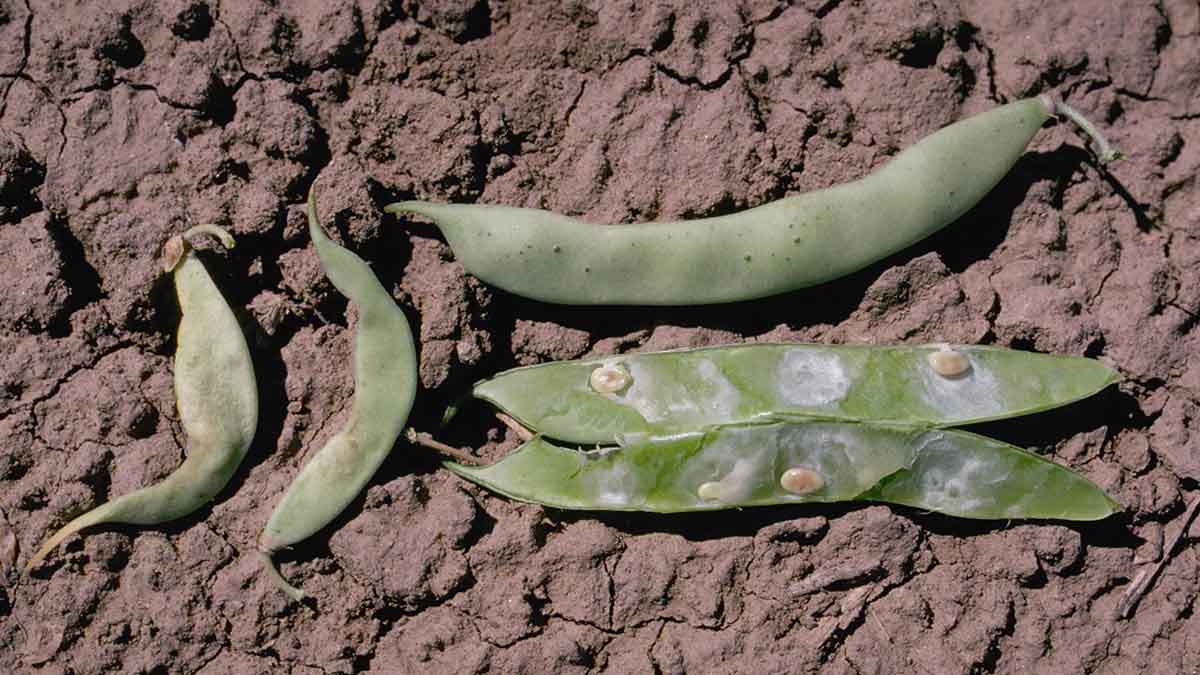Lygus Bugs
Pest Common Name
- Lygus bug, Tarnished plant bug (Lygus hesperus, L. lineolaris, others)
- Crops: alfalfa, canola and other seed crops
- Vegetables and fruit: legumes, potato, tomato, carrot, berries, lettuce and others
- Weeds: chickweed, redroot pigweed dock, fleabane, goldenrod, vetch and others
Adult lygus are about 1/5 inch (6 mm) in length, and can range in color from pale green, to brown or black. Adults have yellow, black and red markings, with a distinctive yellow or green “V” on the upper center of the back. Lygus adults can sometimes be mistaken for other plant bugs and the beneficial big-eyed bug, but their characteristic markings and the clear, membranous ends of the wings of lygus can help distinguish them.
Nymphs are similar to adults in shape but are slightly more rounded and smaller. In fact, nymphs are often small enough to be mistaken for aphids but can be distinguished by their lack of cornicles (narrow, backward facing tubs found on the abdomen of aphids), and more rapid movements. Nymphs also have five black dots on the back and lack the wings of the adult form (Figure 1).
Lygus bug eggs are individually inserted into plant tissues or at the base of leaf blades. They are whiteish, slightly curved, and develop a flattened top when nymphs emerge.

Biology
The lygus bug life cycle consists of egg, nymph and adult. Adults overwinter in weedy areas and in plant debris on the ground. When adults emerge in early spring, they lay their eggs on stems, leaves and flowers of host plants. Eggs hatch into nymphs in about 10 days, depending on the temperature. It takes about 15-30 days for lygus nymphs to go through all five nymphal stages or “instars” and reach adulthood. There can be one to three generations of lygus bugs per year, depending on the location and temperature. Warm and dry conditions favor lygus development.
Damage
Lygus bugs can feed on flowers, leaves and seeds. They feed with piercing-sucking mouthparts, puncturing plant tissues and injecting digestive enzymes into the plant. This feeding can cause damage to any part of the plant, potentially leading to the premature drop of buds, flowers or fruits, ragged or discolored leaves and shriveling/deformation of seeds. Feeding on seeds can cause deformation in fruits (e.g., cat facing), as well as poor germination and marketability in seed crops. Lygus damage can be extremely problematic in some crops (Figure 2). For instance, when lygus populations are large in alfalfa, seed yields can be reduced by almost 100%. However, keep in mind that lygus feeding can sometimes be mistaken for other causes of crop damage. For instance, poor pollination also causes cat facing in fruit, and rough harvesting or handling in seed crops or legumes can cause lygus-like damage. This means that careful monitoring is key.

Monitoring
Watch for damage to plants for the duration of the growing season as lygus may be present and actively feeding throughout. Begin scouting or sweep net sampling for adults and nymphs starting in early spring, before flowering. Keep in mind lygus numbers can increase rapidly during warm, dry weather or when nearby fields that host high lygus numbers are harvested (particularly alfalfa, which is a preferred host).
For peas, fields should be monitored weekly or biweekly from flowering until seeds become firm within the pod. Conduct sampling on sunny days above 59 degrees Fahrenheit (15°C). Sample five locations, 82 feet (25 m) apart in a “W” shape in the field. For each of the five samples, make 25, 180 degree sweeps with a sweep net with a diameter of 15 inch (38 cm). Calculate the average number of lygus, both nymphs and adults, per 25 sweeps. Refer to the thresholds below to determine what management is recommended based on monitoring findings.
Average lygus/25 sweeps and recommended action:
- Less than 7 — Continue scouting
- 7-9 — Continue frequent scouting
- 10 or more — Economic threshold reached; treatment recommended
Management
Primary Management Tactics
Removing weeds from around fields can reduce populations of overwintering adults and ensure that no flowering weeds attract adult lygus in the spring. Avoid moving weeds directly adjacent to crops when those crops are in vulnerable stages (i.e., budding or flowering), as lygus will move from disturbed areas into crops.
Cultural (changing the way the crop is grown to make it less suitable for the pest or to enhance its ability to withstand pest attack)
- Control flowering weeds (e.g., asters, chickweed and goldenrod) early in the season, as they can attract and host lygus
- Controlling weeds later in the season removes overwintering habitat
- Alfalfa borders can be an effective trap crop, and leaving uncut strips during alfalfa harvest can slow movement of lygus from alfalfa fields to surrounding crops
- Early seeding may ensure plants has advanced past vulnerable stages by the time lygus numbers have crossed economic thresholds
Biological
- Avoiding broad-spectrum insecticides can protect natural enemies of lygus bugs such as parasitoid wasps (Peristenus sp.), spiders, damsel bugs (Nabis spp.), minute pirate bugs (Orius tristicolor) and big-eyed bugs (Geocoris spp.)
Chemical
- Generally, insecticide applications should occur after lygus egg hatch is complete, but before nymphs have reached the 4th-5th instar
- If applying insecticides to flowering plants, try to apply during periods of low bee activity (early morning or late evening)
- Limit application frequency and rotate insecticides with different modes of action to avoid development of resistance, which has been documented in lygus populations
- Recommendations for pesticides to use in the management of lygus bugs can be found on the PNW Pest Management Handbooks website.
Pesticide Warning
Always read and follow the instructions printed on the pesticide label. The pesticide recommendations in this University of Idaho webpage do not substitute for instructions on the label. Pesticide laws and labels change frequently and may have changed since this publication was written. Some pesticides may have been withdrawn or had certain uses prohibited. Use pesticides with care. Do not use a pesticide unless the specific plant, animal or other application site is specifically listed on the label. Store pesticides in their original containers and keep them out of the reach of children, pets and livestock.
Trade Names — To simplify information, trade names have been used. No endorsement of named products is intended nor is criticism implied of similar products not mentioned.
Groundwater — To protect groundwater, when there is a choice of pesticides, the applicator should use the product least likely to leach.
- Figure 1. Erik J. Wenninger, University of Idaho
- Figure 2. Howard F. Schwartz, Colorado State University, Bugwood.org
Desiree Wickwar, Entomologist, IPM Program Manager
Sanford Eigenbrode, Distinguished Professor of Entomology
2023








